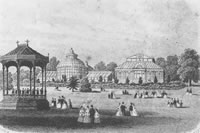The History of Birmingham Botanical Gardens
 The 18th and early 19th centuries were times of global exploration, which resulted in the discovery and introduction to Britain of enormous numbers of new plants from all over the world, including many unknown even to botanists. These novelties aroused such interest among well-to-do middle-class citizens that botanical and horticultural societies were set up all over the country. Birmingham Botanical and Horticultural Society, which manages the Birmingham Botanical Gardens, was founded in 1829 with an initial subscription capital of £2,000. The site selected was ‘Holly Bank Farm’, farmed purely for recreation by a successful fire insurance broker on 18 acres of leased land on Lord Calthorpe¹s Estate. The Gardens were designed by J.C. Loudon, a Scotsman who was a leading garden planner, horticultural journalist and publisher.
The 18th and early 19th centuries were times of global exploration, which resulted in the discovery and introduction to Britain of enormous numbers of new plants from all over the world, including many unknown even to botanists. These novelties aroused such interest among well-to-do middle-class citizens that botanical and horticultural societies were set up all over the country. Birmingham Botanical and Horticultural Society, which manages the Birmingham Botanical Gardens, was founded in 1829 with an initial subscription capital of £2,000. The site selected was ‘Holly Bank Farm’, farmed purely for recreation by a successful fire insurance broker on 18 acres of leased land on Lord Calthorpe¹s Estate. The Gardens were designed by J.C. Loudon, a Scotsman who was a leading garden planner, horticultural journalist and publisher.
Apart from the glasshouses, the general layout is much the same today as Loudon¹s 1830 plan. Planning and construction took 3 years and the gardens opened to Society members on June 11 1832. The glasshouses were the subject of discord between the Society and the designer, whose plans for a very large circular house were rejected on financial grounds and replaced by a simpler suite constructed by a local firm.
The glasshouses have always been a major attraction: the Tropical House was built in 1852 to house the famous tropical water lily, Victoria amazonica; the Subtropical House in 1871 and the present range of Terrace Glasshouses replaced the original conservatory and lean-to houses in 1884. The Tropical House was rebuilt during 1990/91 and the other houses improved and replanted during the major redevelopments carried out in 1986/87. Throughout their history, the Gardens have been important as a centre for social functions in the City, for flower shows, political meetings, festivals of drama and music, wedding receptions, but especially as a place to take the children on day trips. Sunday concerts in the bandstand, built in 1873, remain perennially popular.
The Gardens were originally stocked at relatively little expense because of generous gifts of plants and seeds from similar institutions and botanic gardens in many parts of the world; from the Chiswick Garden of the London Horticultural Society (which later became the RHS), the Berlin Botanic Garden, and 12 boxes of orchids were received from Brazil. Many of the leaders of industry in the Midlands and politicians, both local and national, have been members of the Society, prominent among them the Chamberlain and Nettlefold families. Joseph Chamberlain was President of the Society in 1876 and Neville Chamberlain its Treasurer from 1902 – 1907 and their influence, and that of Hugh Nettlefold, helped the Gardens to survive times of financial stress, as did the support of many other local citizens, a practice that still continues. In an effort to increase the membership of the Society, a zoological collection was started in 1910, well before any such enterprise elsewhere in the region. The list of animals to be seen in succeeding years included monkeys, seals, alligators, pythons and wallabies, but the best remembered are the three bears, one of which,Gladly – the cross-eyed bear¹, is a well-known mondegreen of a hymn. The most recent addition of zoological interest is an Aviary constructed in 1995, housing a varied collection of birds in four separate flights.
1The hymn was called ‘Gladly the cross I’d bear’, and a ‘mondegreen’ is the term used for the re-phrasing of a well-known phrase, which then sounds the same as the original.
The Gardens are also a part of the Birmingham Heritage Forum and host various events in conjunction with the organisation.



